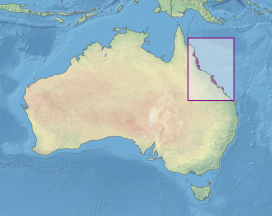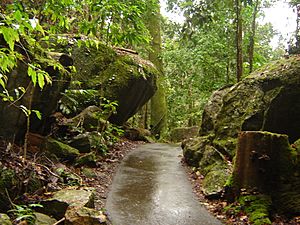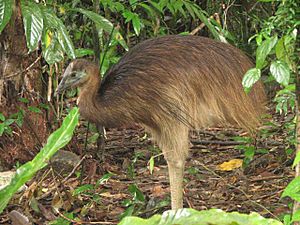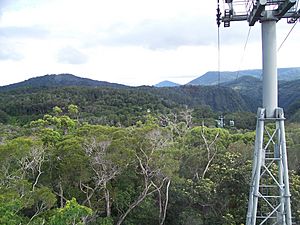Queensland tropical rain forests facts for kids
Quick facts for kids Queensland tropical rain forests |
|
|---|---|

Daintree Rainforest, Queensland
|
|

Ecoregion territory (in purple)
|
|
| Ecology | |
| Realm | Australasian realm |
| Biome | tropical and subtropical moist broadleaf forests |
| Geography | |
| Area | 33,129 km2 (12,791 sq mi) |
| Countries | Australia |
| States | Queensland |
| Coordinates | 21°15′S 148°45′E / 21.25°S 148.75°E |
| Conservation | |
| Conservation status | Vulnerable |
| Global 200 | Queensland tropical rain forests |
| Protected | 3,260 km² (10%) |
The Queensland tropical rain forests are special forests found along the coast of Queensland in northeastern Australia. They are part of the Australasian realm, which includes Australia and nearby islands. These forests are like a living museum! They hold the best record of how land plants have changed over millions of years. Many plants here are "relict species," meaning they are very old types of plants from the ancient supercontinent called Gondwana.
The history of how marsupials (like kangaroos and koalas) and songbirds developed is also well shown in these forests.
Contents
Where are the Queensland Tropical Rain Forests?
This amazing forest area covers about 32,700 square kilometers (12,600 square miles) in northeastern coastal Queensland. It stretches from the coast up to mountains and high plateaus.
The ecoregion is split into three main parts:
- The northern part is the biggest. It includes the city of Cairns and is known as the Wet Tropics.
- The middle part is around Mackay, Queensland.
- The southern part is just south of Shoalwater Bay.
These forests rise from sea level up to 1,477 meters (4,846 feet) high. The average height is about 301 meters (988 feet).
What is the Climate Like?
The climate in these forests is called a Dry-winter humid subtropical climate. This means it's generally warm, with no month averaging below 0°C (32°F). At least one month is warmer than 22°C (72°F).
The amount of rain changes a lot here. It can get between 1,200 and 8,000 mm (47 to 315 inches) of rain each year. The rainy season is from November to April. During these wet summer months, it rains much more than in the winter.
Plants and Animals of the Rain Forests
The Queensland tropical rain forests are considered one of the Global 200 ecoregions. This means they are very important for nature around the world. They are the largest remaining part of Australia's ancient rain forest plants. These plants are related to the "Antarctic flora" found today in New Zealand and southern Chile.
Scientists know from old pollen that thick forests covered most of Australia about 50 to 100 million years ago. The plants in these Queensland forests are the closest living examples of those ancient plants. All of Australia's unique plants developed from these types of forests.

Today, about 65% of this ecoregion is dense forest with broadleaf evergreen trees. Special cone-bearing trees from the southern hemisphere, like those in the family Araucariaceae, are common.
- In the northern part, Kauri trees often form the top layer of the forest. Agathis robusta is common at lower heights. A. microstachya and A. atropurpurea grow higher up.
- In the southern parts, Araucaria cunninghamii is most common. Araucaria bidwillii is found in two smaller areas.
- Other cone-bearing trees like Podocarpus and Sundacarpus are also here.
These forests are full of climbing vines, ferns, epiphytes (plants that grow on other plants), and palms.
These rain forests only grow where there is a lot of rain and good soil. In wet, swampy soils, different plants like Melaleuca bushes grow. In poor or drier soils, Eucalyptus trees become more common.
Rain forest plants don't like fire. If there are long dry periods that cause big fires, the rain forest shrinks. Fire-loving Eucalyptus trees then take over. If it stays wet for a while, the rain forest can grow back.
Some people think that the way Aboriginal Australians managed the land, by setting regular fires, helped Eucalyptus forests spread. This might have caused the rain forests to shrink. These rain forests have become much smaller since the ancestors of Aboriginal people arrived about 50,000 years ago. Now, they cover less than 2% of Australia.

The animal life here is also very rich!
- 672 different kinds of land animals have been found in this ecoregion.
- This includes 370 types of birds, 70 types of reptiles, and 78 types of freshwater fish.
- About 11% of the land animals and 22% of the reptiles found here live nowhere else in the world. Most of these unique species live about 400 meters (1,300 feet) high in the rain forest.
Protecting the Rain Forests
These forests are very special because of their location in the south and because so many of their plants and animals are found only here.
Sadly, deforestation (cutting down forests) has caused problems. Logging, building roads, and farming have broken up the forest into smaller pieces. This makes it harder for animals like the spotted-tailed quoll (Dasyurus maculatus), cassowary (Casuarius casuarius), and ring-tail possum (Hemibelideus lemuroides) to survive. Also, animals and plants brought in from other places can harm the native species.
To help protect the Daintree Rainforest north of the Daintree River, the Queensland Government decided in 1993 to stop extending the electricity network there. This helps limit how much tourist development can happen.
Many areas in these forests are protected, including:
|
|
Visiting the Rain Forests

These forests, along with the Great Barrier Reef, are a big reason why people visit Tropical North Queensland. One of the most popular ways to see the rain forests is by riding the Skyrail Rainforest Cableway.
See also
 In Spanish: Bosques tropicales de Queensland para niños
In Spanish: Bosques tropicales de Queensland para niños

